S&P 500 earnings
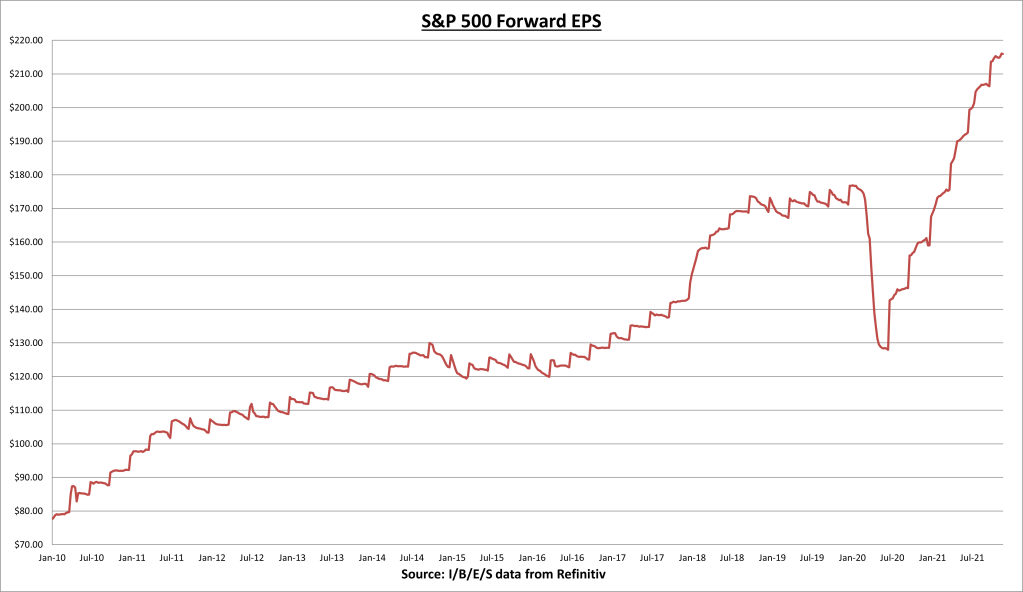
S&P 500 earnings per share (EPS) declined modestly this week, from $216.03 to $215.97.
99% of S&P 500 companies have now reported Q3 results. 81% have beat expectations and earnings have come in a combined 10.3% above estimates. Q3 earnings growth currently stands at +42.6%. (I/B/E/S data from Refinitiv).

S&P 500 price to earnings (PE) ratio fell to 21x, as the index declined -1.22% for the week.
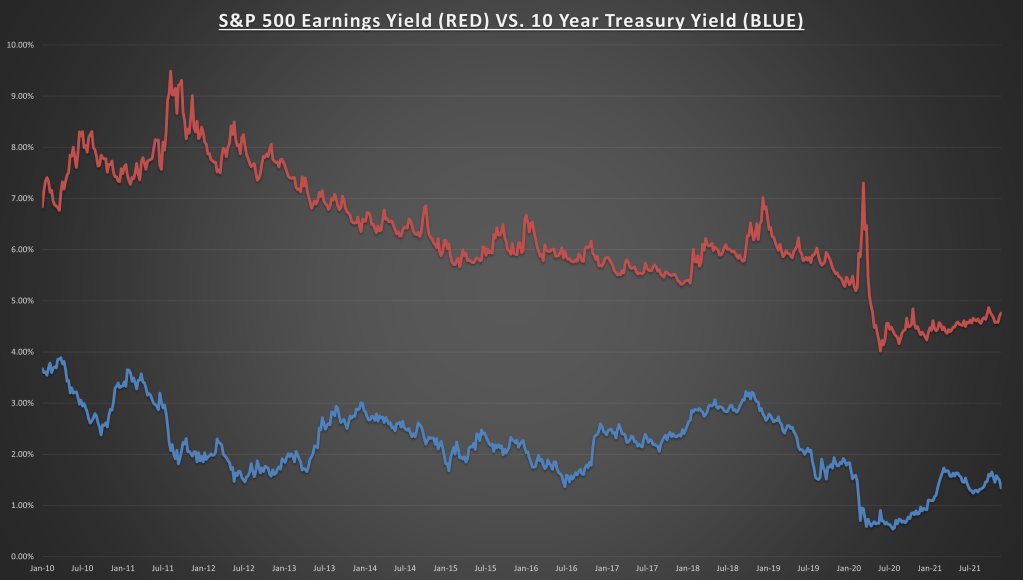
S&P 500 earnings yield is now 4.76%, compared to the 10-year Treasury bond rate which declined to 1.34%.
Economic data review
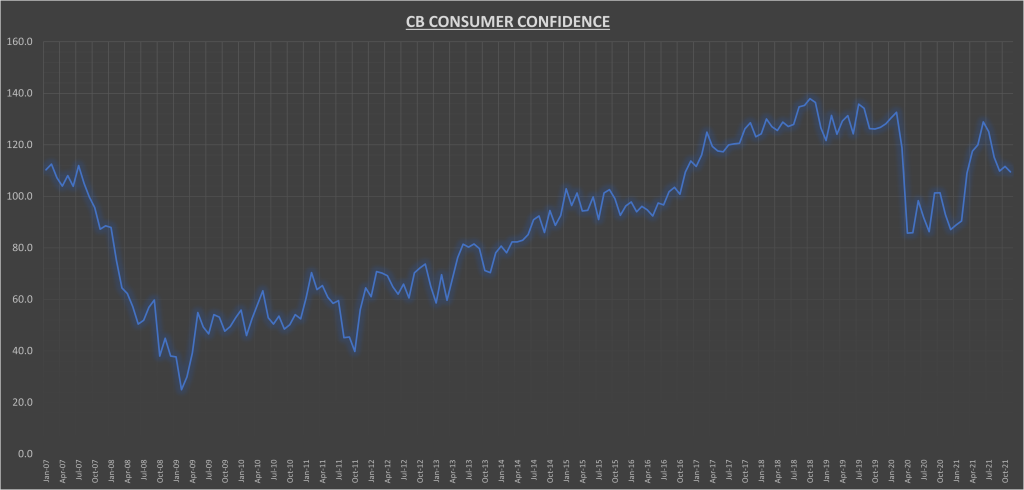
Consumer confidence declined in November, falling to 109.5 while October was also revised lower.
“Expectations about short-term growth prospects ticked up, but job and income prospects ticked down. Concerns about rising prices—and, to a lesser degree, the Delta variant—were the primary drivers of the slight decline in confidence. Meanwhile, the proportion of consumers planning to purchase homes, automobiles, and major appliances over the next six months decreased.
"The Conference Board expects this to be a good holiday season for retailers and confidence levels suggest the economic expansion will continue into early 2022. However, both confidence and spending will likely face headwinds from rising prices and a potential resurgence of COVID-19 in the coming months.”
Consumers expectations index—based on expectations for business conditions, labor markets, and financial prospects 6 months out—also declined. Labor market outlook and financial prospects expectations fell and business conditions outlook improved slightly.
Despite the disappointing monthly results, the consumer confidence index is still higher than it was at this point last year.
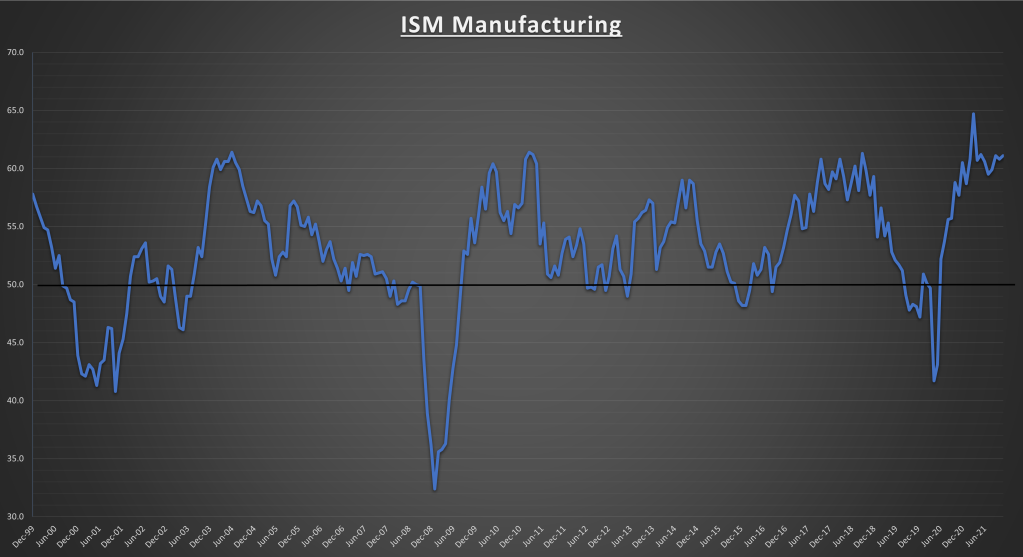
ISM Manufacturing Purchasing Managers Index (PMI) for November came in at 61.1, a slight increase over last month (60.8), and remains well in expansion territory (any reading above 50 indicates expansion).
“The U.S. manufacturing sector remains in a demand-driven, supply chain-constrained environment, with some indications of slight labor and supplier delivery improvement. All segments of the manufacturing economy are impacted by record-long raw materials and capital equipment lead times, continued shortages of critical lowest-tier materials, high commodity prices and difficulties in transporting products.
"Coronavirus pandemic-related global issues—worker absenteeism, short-term shutdowns due to parts shortages, difficulties in filling open positions and overseas supply chain problems—continue to limit manufacturing growth potential. However, panel sentiment remains strongly optimistic, with 10 positive growth comments for every cautious comment.”
New Orders improved from 59.8 to 61.5, employment improved from 52 to 53.3 and prices (input costs) declined from 85.7 to 82.4.

BLS employment report for November came in well below expectations, at 210K net jobs gained, the lowest since December 2020. Total private payrolls increased +235K, while government jobs decreased -25K. And September and October results were revised higher by a combined +82K jobs.
Average hourly earnings grew +0.3% for the month, and now +4.8% higher over the last 12 months.
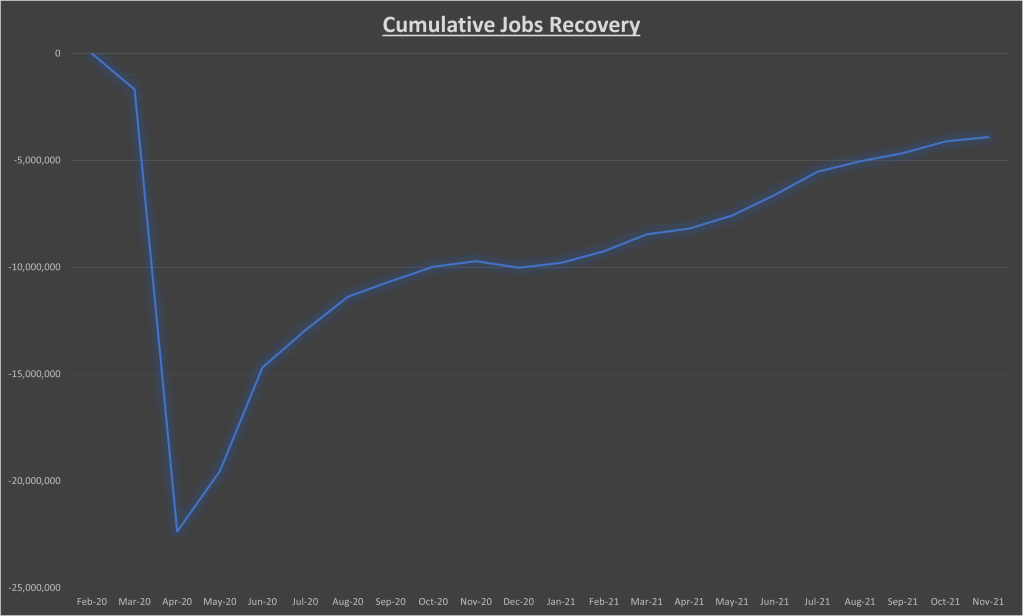
We’ve now recovered 82.5% of the net jobs lost to the COVID recession, but still 3.912 million net jobs below the prior peak.

ISM Services Purchasing Managers Index (PMI) came in at a record high 69.1 for November.
“In November, record growth continued for the services sector, which has expanded for all but two of the last 142 months. Demand continues to outpace supply that has been impacted by capacity constraints, shortages of labor and materials, and logistical challenges. This has also caused demand-pull inflation that is affecting overall business conditions.”
New orders came in the same as last month (69.7), in strong growth territory, and input prices dropped slightly, from 82.9 to 82.3.
“The past relationship between the Services PMI® and the overall economy indicates that the Services PMI® for November (69.1 percent) corresponds to a 6.9-percent increase in real gross domestic product (GDP) on an annualized basis.” (emphasis mine)
Notable earnings
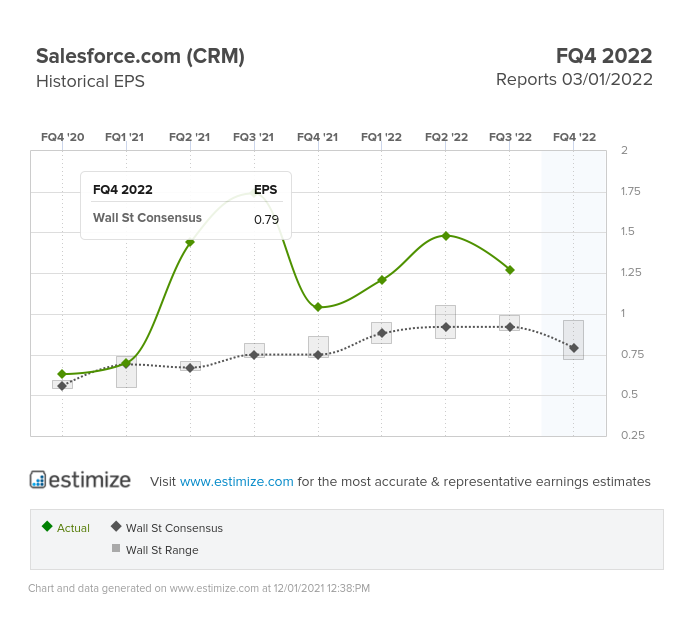
Salesforce (NYSE:CRM) reported quarterly earnings that were 38% above street expectations, while sales came in 1% above street expectations and a growth rate of 27%. This was the first full quarter since the Slack acquisition and the company reported 51% sales growth in the platform/other segment (which includes Slack), along with 17% sales cloud growth, 21% service cloud growth, 20% data segment growth, and 25% marketing cloud growth.
The stock fell about 6% after earnings as the company gave its forward guidance of sales that came in better than expectations, but earnings guidance fell short.
“No other software company of our size or scale is really performing at this level. We know that because we’re talking to other cloud CEOs every day.”
Light earnings forecast doesn’t have a material impact in my opinion. Would look to add to the positions on any follow through on the sell off.
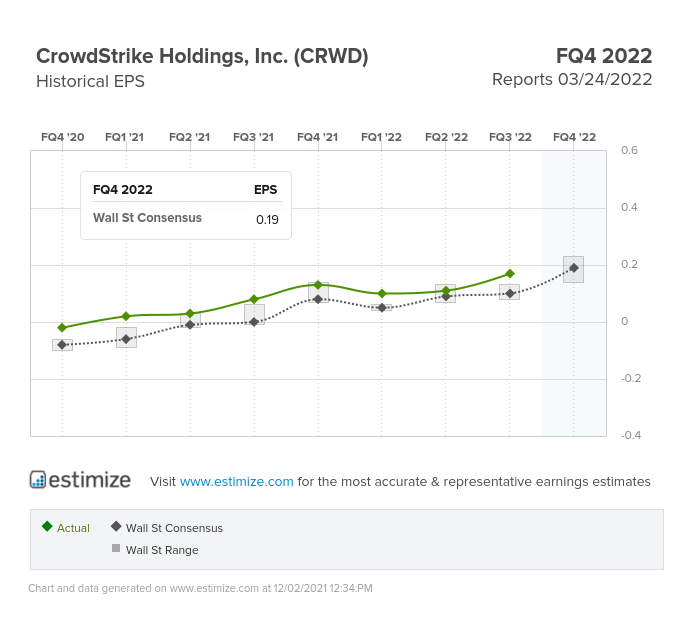
CrowdStrike (NASDAQ:CRWD) reported adjusted EPS that was 70% above street expectations (+113% growth), on revenues that were 5% above expectations and 63% growth. Cash flow from operations grew 80%, and free cash flow grew 62%.
1,607 net new subscription customers were added for the quarter, bringing the running total up to 14,687 (+75% growth), and the company is expanding its relationship with the US government to provide endpoint protection and response.
68% of customers are using 4 or more modules (up from 61% last year), and 32% of customers are using at least 6 modules (up from 22% last year). Showing that the company is building a competitive advantage through the power of customer switching costs.
The stock is not cheap by any means (250x forward EPS & 40x sales), but its declined about 30% over the last few weeks. Would be looking to add to the positions if there is follow through.

Veeva Systems (NYSE:VEEV) reported EPS that was 10% above expectations (24% growth), on revenues that were 2% above expectations (26% growth). The company continued to cite some short term issues facing commercial cloud software, anticipating a 10% reduction in the number of pharma sales reps across the industry.
Q4 projections on sales ($478 to $480 million) came in slightly below street expectations, while Q4 EPS came in slightly above expectations ($0.88 actual vs. $0.87 estimate). Despite the near term headwinds, the $3 billion annual sales target by 2025 still looks well in tact.
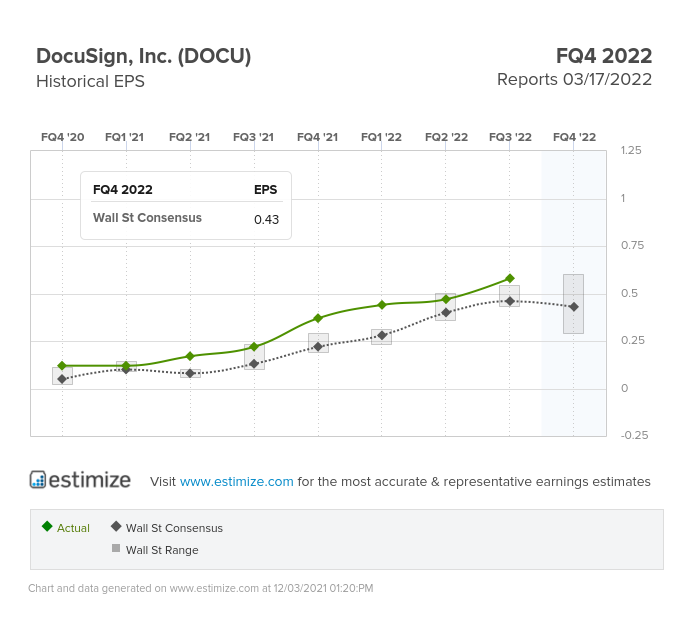
DocuSign (NASDAQ:DOCU) reported EPS that was 26% above street expectations (+164% growth) on sales that were 2.4% above expectations (+42% growth). But it was all about the billings and forward guidance, which was a big and unexpected miss.
The company now expects $560 million in Q4 sales (street was expecting around $574 million), for a growth rate of approximately 32%, which would be the slowest quarterly sales growth rate since IPO. The weakness in billings suggests the soft sales forecast will last for awhile.
As a result the stock is getting hammered (down about 30% as I type this). The company focused on meeting the sharp spike in demand, while lead generation fell short, and now they are paying the price for it.
Summary
The week began with some positive news regarding Black Friday sales, with total sales coming in +29.8% above last year, as store traffic increased 42.9% (still down 28% compared to 2019). Still the COVID variant loomed in the background. We saw the effect that Delta had on Q3 GDP, so it seems inevitable now that Q4 and Q1 2022 economic growth estimates will need to be revised lower. But by how much?
By Tuesday it appeared the market was ready to move on but then Fed Chairman Powell thought it was a good time to finally admit the Fed was wrong all along to call inflation “transitory” (about a year too late Jay), and that a faster pace of tapering was warranted (which means rate increases likely coming even sooner).
We still don’t have any idea what the economic effects of the new variant (because of draconian restrictions and mandates) will be, still he thought this was a good time to surprise the market.
Then Wednesday, Treasury Secretary Yellen maintains her stance that stimulus was “at most a small contributor to inflation.” So we are supposed to believe that a 30%+ increase in the money supply doesn’t have an inflationary effect.
We have a real epidemic in regards to the lack of accountability from our elected officials. No one wants to take responsibility, they just want to pass the blame onto someone or something else. Not our finest week for the Fed Chair and Treasury Secretary. Odds of a policy mistake increase.
The data continues to support the recovery, but we may be starting to see inflation finally having a negative impact on demand. This week, Apple (NASDAQ:AAPL) warned suppliers that iPhone 13 demand may be softening. Up to now consumers accepted higher prices because of stimulus offsets. We can’t count on that going forward.
It was an eventful week with some volatile market moves. We may be in the middle of a perfectly normal and healthy market correction, with growth stocks especially taking it on the chin, but the fundamentals continue to be supportive for risk assets.
Next week: 6 S&P 500 companies will be reporting earnings. For economic data we have the Consumer Price Index (CPI) on Friday.
